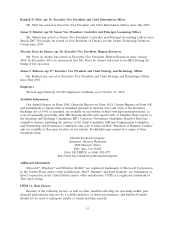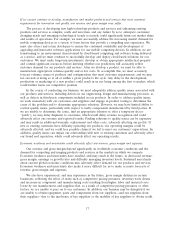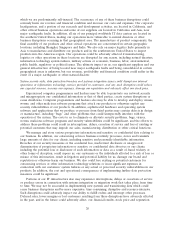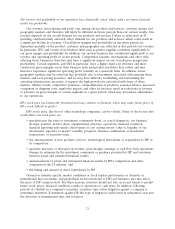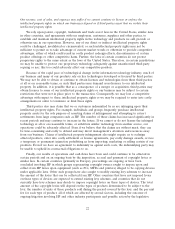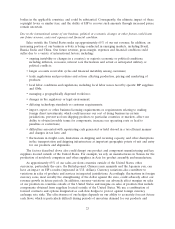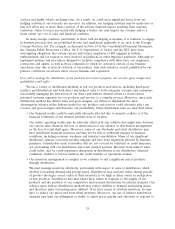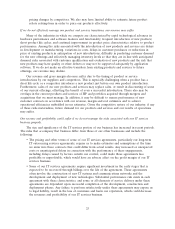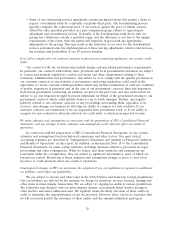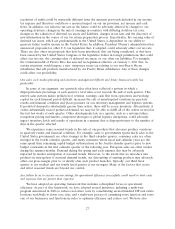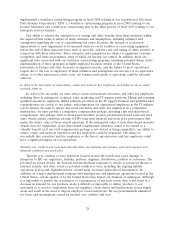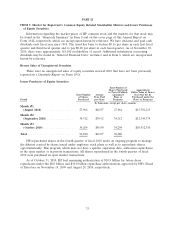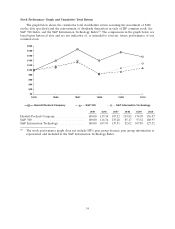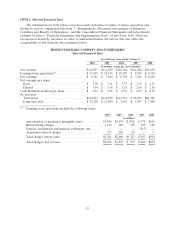HP 2010 Annual Report Download - page 33
Download and view the complete annual report
Please find page 33 of the 2010 HP annual report below. You can navigate through the pages in the report by either clicking on the pages listed below, or by using the keyword search tool below to find specific information within the annual report.pricing changes by competitors. We also may have limited ability to estimate future product
rebate redemptions in order to price our products effectively.
If we do not effectively manage our product and services transitions, our revenue may suffer.
Many of the industries in which we compete are characterized by rapid technological advances in
hardware performance and software features and functionality; frequent introduction of new products;
short product life cycles; and continual improvement in product price characteristics relative to product
performance. Among the risks associated with the introduction of new products and services are delays
in development or manufacturing, variations in costs, delays in customer purchases or reductions in
price of existing products in anticipation of new introductions, difficulty in predicting customer demand
for the new offerings and effectively managing inventory levels so that they are in line with anticipated
demand, risks associated with customer qualification and evaluation of new products and the risk that
new products may have quality or other defects or may not be supported adequately by application
software. If we do not make an effective transition from existing products and services to future
offerings, our revenue may decline.
Our revenue and gross margin also may suffer due to the timing of product or service
introductions by our suppliers and competitors. This is especially challenging when a product has a
short life cycle or a competitor introduces a new product just before our own product introduction.
Furthermore, sales of our new products and services may replace sales, or result in discounting of some
of our current offerings, offsetting the benefit of even a successful introduction. There also may be
overlaps in the current products and services of HP and portfolios acquired through mergers and
acquisitions that we must manage. In addition, it may be difficult to ensure performance of new
customer contracts in accordance with our revenue, margin and cost estimates and to achieve
operational efficiencies embedded in our estimates. Given the competitive nature of our industry, if any
of these risks materializes, future demand for our products and services and our results of operations
may suffer.
Our revenue and profitability could suffer if we do not manage the risks associated with our IT services
business properly.
The size and significance of the IT services portion of our business has increased in recent periods.
The risks that accompany that business differ from those of our other businesses and include the
following:
• The pricing and other terms of some of our IT services agreements, particularly our long-term
IT outsourcing services agreements, require us to make estimates and assumptions at the time
we enter into these contracts that could differ from actual results. Any increased or unexpected
costs or unanticipated delays in connection with the performance of these engagements,
including delays caused by factors outside our control, could make these agreements less
profitable or unprofitable, which would have an adverse affect on the profit margin of our IT
services business.
• Some of our IT services agreements require significant investment in the early stages that is
expected to be recovered through billings over the life of the agreement. These agreements
often involve the construction of new IT systems and communications networks and the
development and deployment of new technologies. Substantial performance risk exists in each
agreement with these characteristics, and some or all elements of service delivery under these
agreements are dependent upon successful completion of the development, construction and
deployment phases. Any failure to perform satisfactorily under these agreements may expose us
to legal liability, result in the loss of customers and harm our reputation, which could decrease
the revenues and profitability of our IT services business.
25


